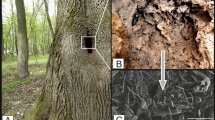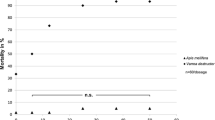Abstract
The potential of some natural compounds (thymol, vetiver essential oil, lysozyme, resveratrol) for the control of nosema infection in honeybees was evaluated. A first trial aimed at screening substances, in candy preparations, on the basis of their toxicity to honeybees and bees’ dietary preferences. None of the tested substances showed an increased bee mortality or decreased bee preference, and were therefore considered suitable for further testing. In the second trial the effects of the natural compounds on nosema diseased honeybees were evaluated: bees were individually dosed with nosema spores and fed candies prepared with the screened substances. The results showed that bees fed with thymol and resveratrol candies had significantly lower infection rates, and bees supplied with resveratrol prepared candy also lived significantly longer. We suggest that thymol and resveratrol could be useful in alternative strategies for the control of nosema disease.
Zusammenfassung
Effektive Wirkstoffe zur Bekämpfung der Nosemose werden europaweit dringend benötigt, da es keine zugelassenen Präparate gibt und sich die Krankheit zunehmend ausbreitet. Die Nosemose ist ein weltweites Problem für die Bienenhaltung. Die Krankheit wird durch die Mikrosporidien Nosema apis Zander und Nosema ceranae Fries verursacht, wobei sie als obligate Parasiten des Darmepithels die adulten Bienen schädigen. Die Ansteckung erfolgt über Sporen, die in großer Menge im Kot von kranken Bienen nachweisbar sind. Sie sind länger als ein Jahr in Waben und Wasser infektiös und können zusätzlich über Trophallaxis verbreitet werden. Das einzige bisher wirksame Produkt zur Bekämpfung der Nosemose ist das Antibiotikum Fumagillin, das aber in vielen Ländern verboten ist. Das Ziel dieser Untersuchung war es, verschiedene Naturstoffe, die ohne das Risiko einer Rückstandsbildung in Bienenprodukten eingesetzt werden können, hinsichtlich ihrer Wirksamkeit gegen die Nosemose zu testen. Da von Thymol, Vetiveröl, Lysozym und Resveratrol bereits Berichte über inhibitorische Wirkungen auf Mikrosporidien vorlagen, wurden diese für die Tests ausgewählt und den Bienen über das Futter appliziert. In einem ersten Versuch wurden die Substanzen in zwei unterschiedlichen Konzentrationen hinsichtlich der toxischen Effekte und ihrer Akzeptanz als Futterzusatz geprüft. Jeweils 20 Bienen wurden in kleinen Holzkäfigen bei 33 °C und 70 % RF im Dunkeln gehalten und die Futterabnahme sowie die Anzahl toter Bienen bis zum elften Tag erfasst. Dabei wurden keine Unterschiede zwischen den unterschiedlich gefütterten Versuchsgruppen festgestellt (Abb. 1, 2). In einem zweiten Versuch wurden Nosema-freie Bienen einzeln mit 1 μL einer sporenhaltigen Zuckerlösung mit jeweils 18000 N. ceranae Sporen gefüttert. 30 Bienen pro Käfig wurden mit Zuckerteig, der jeweils die höchste getestete Konzentration der o. a. Substanzen enthielt, gefüttert. Aus jedem Käfig wurden 8, 13, 19 und 25 Tage nach Versuchsbeginn je 2 Bienen entnommen und deren Sporenbelastung bestimmt, um die Entwicklung der Nosemainfektion zu verfolgen. Zusätzlich wurde täglich die Anzahl toter Bienen registriert, um die Überlebensraten zu berechnen. Die mit Resveratrol gefütterten Bienen wiesen eine signifikant höhere mittlere Überlebenszeit auf (Abb. 3, Tab. II). Bei Bienen, die mit Resveratrol und Thymol gefüttert wurden, kam es am letzten Untersuchungszeitpunkt (Tag 25) zu einer Reduzierung des Nosema-Infektionsgrades, während in den anderen Gruppen die Anzahl an Sporen zunahm (Tab. III). Bei den mit Thymol gefütterten Bienen war die Sporenkonzentration zu allen Untersuchungszeitpunkten am geringsten. Es scheint, dass Thymol und Resveratrol geeignete Substanzen sind, um die Entwicklung des Parasiten zu hemmen. Thymol wird bereits als wirksames Akarizid gegen Varroa-Milben in der Imkerpraxis eingesetzt und Resveratrol ist bekannt für seine spezifischen antioxidativen Eigenschaften, die in anderen Versuchen bereits zur Verlängerung der Lebensdauer kleiner Invertebraten geführt haben.
Similar content being viewed by others
References
Albo G.N., Henning C., Ringuelet J., Reynaldi F.J., De Giusti M.R., Alippi A.M. (2003) Evaluation of some essential oils for the control and prevention of American Foulbrood disease in honey bees, Apidologie 34, 417–427.
Assil H.I., Sporns P. (1991) ELISA and HPLC methods for analysis of fumagillin and its decomposition products in honey, J. Agric. Food Chem. 39, 2206–2213.
Bailey L., Ball B.V. (1991) Honey bee pathology, Academic Press, London.
Barbara L., Pellegrini R. (1975) Il lisozima di Fleming. Significato biologico e applicazioni terapeutiche, Edizioni Minerva Medica, Torino.
Bogdanov S., Kilchenmann V., Imdorf A., Fluri P. (1998) Residues in honey after application of thymol against varroa using the franko thymol frame, Am. Bee J. 133, 610–611.
Borchert A. (1966) Krankheiten und Schädlinge der Honigbiene, S. Hirzel Verlag, Leipzig.
Cantwell G.E., Shimanuki H. (1970) The use of heat to control nosema and increase production for the commercial beekeeper, Am. Bee J. 110, 263.
Chiesa F. (1991) Effective control of varroatosis using powdered thymol, Apidologie 22, 135–145.
de Graaf D.C., Raes H., Sabbe G., De Rycke P.H., Jacobs F.J. (1994) Early development of Nosema apis (Microspora: Nosematidae) in the midgut epithelium of the honeybee (Apis mellifera), J. Invertebr. Pathol. 63, 74–81.
Ebert T.A., Kevan P.G., Bishop B.L., Kevan S.D., Downer R.A. (2007) Oral toxicity of essential oils and organic acids fed to honey bees (Apis mellifera), J. Apic. Res. 46, 220–224.
EC (2007) Council Regulation No. 834/2007 of 28 June 2007 on organic production and labelling of organic products and repealing Regulation (EEC) No. 2092/91, Off. J. Eur. Union L189, 20.07.2007, 1–23.
Forsgren E., Fries I. (2003) Acidic food and nosema (Nosema apis) disease, in: Proc. XXXVIIIth Apimondia Int. Apic. Congr Ljubljana, Slovenia, August 24–29, 2003, pp. 488–489.
Fremont L. (2000) Biological effects of resveratrol, Life Sci. 66, 663–673.
Fries I. (1993) Nosema apis — A parasite in the honey bee colony, Bee World 74, 5–19.
Fries I., Feng F., Silva A. da, Slemenda S.B., Pieniazek N.J. (1996) Nosema ceranae n. sp. (Microspora, Nosematidae), morphological and molecular characterization of a microsporidian parasite of The Asian honey bee Apis cerana (Hymenoptera, Apidae), Eur. J. Protistol. 32, 356–365.
Furgala B., Mussen E.C. (1990) Protozoa, in: Morse R.A., Nowogrodzki R. (Eds.), Honey bee pests, predators, and diseases, 2nd ed, Comstock, Ithaca, NY, pp. 49–63.
Gontarski G., Wagner O. (1954) Quantitative Versuche zur chemotherapeutischen Bekämpfung von Nosema apis Zander bei der Honigbiene, Arzneim. Forsch. 4, 161–168.
Henderson G., Heumann D.O., Laine R.A., Maistrello L., Zhu B.C.R., Chen F. (2003) Extracts of vetiver oil as a repellent and toxicant to ants, ticks, and cockroaches, US-2003-0073748-A1, U.S. Patent and Trademark Office.
Higes M., Martín R., Meana A. (2006) Nosema ceranae, a new microsporidian parasite in honeybees in Europe, J. Invertebr. Pathol. 92, 93–95.
Hornitzky M. (2005) Nosema disease. Literature review and survey of bee-keepers. RIRDC Publication No. 05/055, Australian Government, Rural Industries Research and Development Corporation, http://www.rirdc.gov.au/reports/HBE/05-055.pdf.
Huang W.F., Bocquet M., Lee K.C., Sung I.H., Jiang J.H., Chen Y.W., Wang C.H. (2008) The comparison of rDNA spacer regions of Nosema ceranae isolates from different hosts and locations, J. Invertebr. Pathol. 97, 9–13.
Huang W.F., Jiang J.H., Chen Y.W., Wang C.H. (2007) A Nosema ceranae isolate form the honeybee Apis mellifera, Apidologie 38, 30–37.
Imdorf A., Kilchenmann V., Bogdanov S., Bachofen B., Beretta C. (1995) Toxic effects of thymol, camphor, menthol and eucalyptol on Varroa jacobsoni Oud and Apis mellifera L. in a laboratory test, Apidologie. 26, 27–31.
Juven B.J., Kanner J., Schved F., Weisslowicz H. (1994) Factors that interact with the antibacterial action of thyme essential oil and its active constituents, J. Appl. Bacteriol. 76, 626–631.
Katznelson H., Jamieson H. (1952) Control of nosema disease with fumagillin, Science 115, 70–71.
L’Arrivee J.C.M. (1965) Sources of nosema infection, Am. Bee J. 105, 246–248.
Leiro J., Cano E., Ubeira F.M., Orallo F., Sanmartìn M.L. (2004) In vitro effects of resveratrol on the viability and infectivity of the Microsporidian Encephalitozoon cuniculi, Antimicrob. Agents Ch. 48, 2497–2501.
]Lenga R.E. (1988) The Sigma-Aldrich library of chemical safety data, Sigma-Aldrich Corporation 35.
Liu T.P. (1973) Effects of Fumidil B on the spore of Nosema apis and on lipids of the host cell as revealed by freeze-etching, J. Invertebr. Pathol. 22, 364–368.
Lodi R. (1989) Il lisozima: situazioni e prospettive, Il latte 14, 832–833.
Lotmar R. (1940) Beiträge zur Pathologie des Bienendarmes. C. Über den Infektionsverlauf und die Vermehrung des Parasiten Nosema apis (Quantitative Untersuchungen), Landwirtsch. Jb. Schweiz. 54.
Lotmar R. (1943) Über den Einfluß der Temperatur auf den Parasiten Nosema apis, Beih. Schweiz. Bienen-Zeitung 6, 261–284.
MacDonald D.N. (1978) Diseases of the honeybee, Apis mellifera (Hymenoptera: Apidae) in British Colombia, with special emphasis on nosema disease, Nosema apis (Sporozoa: Nosematidae), in the lower Fraser Valley, 13. Simon Fraser University, Canada.
Mahmoud A.L.E. (1999) Inhibition of growth and aflatoxin biosynthesis of Aspergillus flavus by extracts of some Egyptian plants, L. Appl. Microbiol 29, 334–336.
Maistrello L., Henderson G., Laine R.A. (2001a) Effects of nootkatone and a borate compound on Formosan subterranean termite (Isoptera: Rhinotermitidae) and its symbiont protozoa, J. Entomol. Sci. 36, 229–236.
Maistrello L., Henderson G., Laine R.A. (2001b) Efficacy of vetiver oil and nootkatone as soil barriers against Formosan subterranean termite (Isoptera: Rhinotermitidae), J. Econ. Entomol. 94, 1532–1537.
Maistrello L., Henderson G., Laine R.A. (2003) Comparative effects of vetiver oil, nootkatone and disodium octaborate tetrahydrate on Coptotermes formosanus and its symbiotic fauna, Pest. Manage. Sci. 59, 58–68.
Malone L.A., Gatehouse H.S. (1998) Effects of Nosema apis infection on honey bee (Apis mellifera) digestive proteolytic enzyme activity, J. Invertebr. Pathol. 71, 169–174.
Malone L.A., Gatehouse H.S., Tregidga E.L. (2001) Effects of time, temperature, and honey on Nosema apis (Microsporidia: Nosematidae), a parasite of the honeybee, Apis mellifera (Hymenoptera: Apidae), J. Invertebr. Pathol. 77, 258–268.
Malone L.A., Giacon H.A. (1996) Effects of Nosema apis Zander on inbred New Zealand honey bees (Apis mellifera ligustica L), Apidologie 27, 479–486.
Martín R., Meana A., Higes M. (2005) Increase of nosemosis prevalence in Spain, Acta Parasitol. Portug. 12, 50.
Martìn-Hernández R., Meana A., Prieto L., Martìnez Salvador A., Garrido-Bailón E., Higes M. (2007) Outcome of colonization of Apis mellifera by Nosema ceranae, Appl. Environ. Microbiol. 73, 6331–6338.
Moffet J.O., Lackett J.J., Hitchcock J.D. (1969) Compounds tested for control of nosema in honey bees, J. Econ. Entomol. 62, 886–889.
Rice R.N. (2001) Nosema disease in honeybees. Genetic variation and control. Report n. 01/46, Australian Government, Rural Industries Research and Development Corporation.
Sellier N., Cazaussus A. (1991) Structure determination of sesquiterpenes in chinese vetiver oil by gas chromatographytandem mass spectrometry, J. Chromatogr. 557, 451–458.
Szabo T.I., Heikel D.T. (1987) Effect of dry fumagillin feeding on spring Nosema spore counts in over-wintered colonies, Am. Bee J. 127, 210–211.
Valenzano D.R., Terzibasi E., Genade T., Cattaneo A., Domenici L., Cellerino A. (2006) Resveratrol prolongs lifespan and retards the onset of age-related markers in a short-lived vertebrate, Curr. Biol. 16, 296–300.
Viollon C., Chaumont J.P. (1994) Antifungal properties of essential oils e their main components upon Cryptococcus neoformans, Mycopathologia 123, 151–153.
Webster T.C. (1993) Nosema apis spore transmission among honey bees, Am. Bee J. 133, 869–870.
Webster T.C., Pomper K.W., Hunt G., Thacker E.M., Jones S.C. (2004) Nosema apis infection in worker and queen Apis mellifera, Apidologie 35, 49–54.
Wyborn M.H., McCutcheon D.M. (1987) A comparison of dry and wet fumagillin treatments for spring nosema disease suppression of overwintered colonies, Am. Bee J. 127, 207–209.
Yucel B., Dogaroglu M. (2005) The impact of Nosema apis Z. infestation of honey bee (Apis mellifera L.) colonies after using different treatment methods and their effects on the population levels of workers and honey production on consecutive years, Pak. J. Biol. Sci. 8, 1142–1145.
Author information
Authors and Affiliations
Corresponding author
Additional information
Manuscript editor: Marla Spivak
Rights and permissions
About this article
Cite this article
Maistrello, L., Lodesani, M., Costa, C. et al. Screening of natural compounds for the control of nosema disease in honeybees (Apis mellifera). Apidologie 39, 436–445 (2008). https://doi.org/10.1051/apido:2008022
Received:
Revised:
Accepted:
Issue Date:
DOI: https://doi.org/10.1051/apido:2008022




